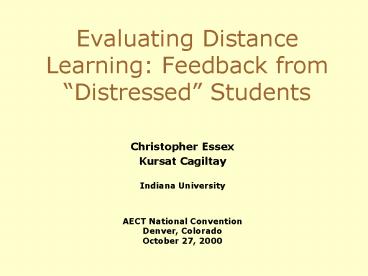Evaluating Distance Learning: Feedback from - PowerPoint PPT Presentation
Title:
Evaluating Distance Learning: Feedback from
Description:
Evaluating Distance Learning: Feedback from Distressed Students Christopher Essex Kursat Cagiltay Indiana University AECT National Convention – PowerPoint PPT presentation
Number of Views:106
Avg rating:3.0/5.0
Title: Evaluating Distance Learning: Feedback from
1
Evaluating Distance Learning Feedback from
Distressed Students
- Christopher Essex
- Kursat Cagiltay
- Indiana University
- AECT National ConventionDenver, ColoradoOctober
27, 2000
2
Our Background in Online DE
- Essex has worked for the Indiana University SOE
Distance Education Program since 1994 - Essex has taught online since Summer 1998
- Cagiltay taught Turkish students online from USA
3
Outline
- Definition of Distress
- Study Background
- Course and Student Profile
- Method
- Findings Positive and Negative Feedback
- Recommendations
- Limitations
4
Online Distance Education Student Distress
- Key References
- Hara, N. and R. Kling (in press). Students'
distress with a web-based distance education
course. Information, Communication and Society.
(Earlier draft is on-line Available
http//www.slis.indiana.edu/CSI/ wp99_01.html) - Mendels, P. (Sept. 22, 1999). Study Finds
Problems With Web Class. New York Times Online
Edition. (On-line). Available
http//www.nytimes.com/library/tech/99/09/cyber/ed
ucation/22education.html - Gale, C. (2000, January). Online learning A
student perspective. Syllabus. pp. 52-53
5
Online Distance Education Student Distress
- Distress situations that the students...find
particularly troublesome. - Social Isolation
- Overwhelming Email Communication
- Lack of Instructor Feedback
- Technical Problems
- Ambiguous Instructions
- (Hara and Kling)
6
Study Background
- The Course
- Focused on the evaluation of Internet resources
for use by K-12 educators and students - Course activities
- Required students to navigate through various
websites, the course website along with a number
of others, send and respond to email messages,
and use a web-based conferencing tool for class
discussion purposes - Instructors role/pedagogy
- Facilitator, guided students through PBL-based
activities and moderated class discussion
7
Study Background
- Our role as evaluators
- The researchers conducted the study from a
third-party perspective, observing impartially
and not involved in making any changes to the
program based on our evaluation.
8
Course Profile
- 100 online course, utilizing course website,
email and asynchronous web-based conferencing - Masters-level, three-credit hour course
- Designed and taught by advanced doctoral student
- Part of an online Masters degree program
9
Student Profile
- Of 11 registered students, 9 responded to at
least one of various survey instruments. Seven
students filled out all the instruments - 100 graduate-level students
- Students were located in Indiana, Hawaii, Iowa,
Tennessee, North Dakota, and Sweden - 4 in on-campus degree program
- 1 in online masters degree program
- 10 enrolled for educational and business-related
reasons--Only 1 registered for personal reasons
10
Methods
- Interviewed instructor
- Reviewed course content/activities
- Developed questions based on Kirkpatricks Four
Levels of Evaluation - Developed online survey instruments
- Integrated surveys into course website
11
Focus of Kirkpatrick Levels
- Level 1 (Student satisfaction)
- Course materials
- Course activities
- Instructor performance
- Overall rating for course
- Level 2 (Student learning)
- Level 3 (Transfer of learning)
- Level 4 (Cost/benefit impact)
12
Positive Student Feedback
- Level 1
- Overall, students gave positive comments
regarding this course. - Level 2
- The students reported a moderate level of
learning. - Level 3
- Students expected professional benefits in the
future from taking the course. - Level 4
- Students responded that the course cost them more
money than on-campus course, but saved them time. - The majority of the students felt that the
cost/benefit ratio of the course was very
favorable.
13
Negative Feedback Distress
- Level 1
- Many students were not very satisfied with their
interactions with the instructor. - Level 2
- A small number of students were not well-prepared
for the technological requirements of this
course, which caused them frustration. - Level 4
- Students responded the course cost them more
money than an on-campus course.
14
Negative Feedback Distress
- Levels 1, 2, 3
- One student, in a moment of distress, made the
following statement "I am totally frustrated. I
absolutely do not know how this class is
organized and how to access the information I
need. I hate Long Distance education and I never
plan to do this ever again. It has made me
rethink even using the Internet in my class at
school. I hate this. I hate this. I hate this."
15
Distress Comparison to Hara and Kling
- Distress situations that the students...find
particularly troublesome. - Social Isolation (not found)
- Overwhelming Email Communication (not found)
- Lack of Instructor Feedback (found)
- Technical Problems (found)
- Ambiguous Instructions (found)
- (Hara and Kling)
16
Recommendations for DE Instructors and Developers
- The instructor should review her practices in
responding to students email and web-based
conferencing posts, to ensure that she is
providing sufficient and appropriate feedback. - The instructor should specify the technological
requirements in the syllabus, and arrange for
technical support. - The instructor should conduct a usability tests
on the course requirements and other instructions
to ensure that they are clear and non-ambiguous. - The distance education program should provide an
on-campus face-to-face orientation. For students
that cannot be on-campus, a video tape should be
provided.
17
Limitations
- Small sample size (though entire class)
- Education students may be atypical
- Lack of follow-up evaluation
- Lack of ability to measure Level 3 (Transfer of
Learning)
18
Questions?
Christopher Essex cessex_at_indiana.edu Kursat
Cagiltay kursat_at_indiana.edu Presentation Online
at http//php.indiana.edu/kursat/evalde-aect-den
ver.ppt

